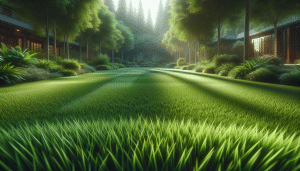You Can Transform Your Home with Vertical Gardens
Henry King September 27, 2025
Step into the world of vertical gardens and unlock a greener lifestyle for your living space. Discover how you can maximize limited areas, boost well-being, and create stunning indoor or outdoor green walls using creative and sustainable approaches.
The Allure of Vertical Gardens Indoors
Vertical gardens bring lush greenery into urban homes, even when floor space is at a premium. Rather than spreading plants across tabletops or windowsills, a living wall rises up, creating dramatic, living artwork. Many residents find that these gardens offer much-needed visual relief, soften harsh lines, and breathe fresh life into small rooms. This design technique continues to climb in popularity, especially for apartment dwellers seeking inventive ways to personalize and refresh their interiors while reaping the mood-boosting effects of green spaces. Vertical gardens turn unused walls into productive, beautiful habitats that enhance surroundings every day.
Having an indoor vertical garden can support air purification and help balance humidity, which is valuable in conditioned environments. By selecting hardy houseplants like pothos, ferns, or philodendrons, it’s possible to create a thriving ecosystem that requires only a little attention. These plant walls not only filter common pollutants but also foster a tranquil atmosphere, making them a favored strategy for mindfulness and interior wellness. Incorporating automatic watering systems means even a busy household can enjoy the benefits with minimal upkeep, freeing residents to enjoy time spent in their newly green retreat.
One notable advantage is how vertical gardens adapt to any style. From sleek and modern frameworks to rustic, reclaimed wood structures, there’s a look for every taste. These adaptable garden features work as statement pieces in entryways, living rooms, or kitchens. Creative homeowners appreciate how plant selection, layout, and lighting can all be customized; succulents, trailing vines, or edible herbs each bring their own personality. The flexibility of materials and plant choices means these gardens seamlessly blend with evolving decor, allowing even small indoor spaces to become interactive, living showcases year-round.
Maximizing Outdoor Spaces with Vertical Planting
For many with limited backyards or balconies, vertical gardens unlock growing possibilities without sacrificing precious ground area. Homeowners use varied approaches, from trellises for climbing flowers to modular pocket panels holding herbs or vegetables upright. Even fences and exterior walls can be transformed with a splash of foliage, turning overlooked structures into calming, productive features. This maximization of vertical real estate allows for homegrown produce, colorful blooms, or serene privacy screens—all while conserving space for recreation or entertaining.
Outdoor vertical gardens are also smart climate acts. In hot areas, plant walls can shade building exteriors, reducing solar heat absorption and potentially supporting lower indoor cooling needs (Source: https://www.epa.gov/heat-islands/using-trees-and-vegetation-reduce-heat-islands). These green barriers help manage rain runoff and promote local biodiversity by attracting beneficial insects and pollinators. With sustainable irrigation and careful plant selection, outdoor vertical gardens can thrive with reduced environmental impact, making them attractive to eco-minded property owners.
Maintenance is an ongoing consideration. Outdoor gardens, exposed to changing weather and pests, require sturdy frames and occasional replanting. Using native or drought-tolerant species can greatly decrease the amount of watering and care needed. Modular structures make it easy to swap plants as seasons shift, ensuring continual color and harvest throughout the year. Many owners delight in sharing surplus herbs, strawberries, or greens grown on these vertical systems with friends and neighbors, fostering a sense of community right on their balconies or patios.
Planning Your Vertical Garden Design
Thoughtful planning underpins a successful vertical garden project. Start by assessing the space’s available light, existing wall structure, and expected weight load for the garden. Understanding microclimates—areas of differing sun, shade, and temperature—is crucial when situating plant containers or trellises. The right spot allows for lush, healthy growth and easier maintenance. Sketching out the desired look, including arrangement patterns, plant heights, and color accents, helps the project feel intentional and cohesive. Don’t rush—measure twice to avoid surprises after installation.
Choosing the garden system is the next central step. Wall-mounted planters, hydroponic mats, recycled pallet frames, and modular pots each cater to different goals and aesthetics. Some gardeners opt for ready-made kits for convenience; others enjoy customizing their own support structures for a personalized effect. The chosen system should match both the selected wall and the intended plants, ensuring adequate drainage, irrigation, and stability. Watering method is also key: manual, automated drip systems, or even self-watering reservoirs can all be incorporated into the structure for different levels of involvement and efficiency (Source: https://hgic.clemson.edu/factsheet/vertical-gardening/).
Last but not least, factor in future growth and plant care. Vertical gardens are dynamic—they change as plants climb, trail, or fill out. Plan for mature plant sizes so the garden continues to look balanced, not crowded. Accessibility is important for monthly tasks like pruning or replanting, so ensure that all areas of the living wall can be reached safely. This foresight saves time and promotes plant health, providing year-round enjoyment and reliable aesthetic appeal for years to come.
Choosing the Right Plants for Vertical Gardens
The choice of plants is central to building a thriving vertical garden, indoors or out. Climate, light exposure, and desired effect should all guide selection. For low-light interiors, species such as pothos, peace lilies, or bird’s nest ferns excel, while bright, sunny spots suit succulents, spider plants, or herbs like basil and oregano. Outdoors, edible gardens can include lettuce, strawberries, or chard, while flowering climbers or trailing groundcovers enhance vertical beauty. Mixing forms and textures provides visual interest while ensuring the health and sustainability of the planting system (Source: https://extension.umn.edu/how/vertical-gardening).
Combining compatible species together can encourage more robust growth and minimize pests or disease. For example, pairing marigolds with vegetables can offer natural pest deterrence. Dense arrangements sometimes benefit from integrating air-purifying or pollinator-friendly blooms. In larger outdoor vertical systems, including some native species supports local wildlife and reduces maintenance. Consider leaf type and growth habits for ease of access and harvest—cascading or upright plants each bring unique value to vertical systems.
Plan for seasonal variety and rotate plant species for continued visual impact. Many vertical gardeners refresh cool-season herbs in spring and fall but switch to heat-loving edibles or ornamental annuals during summer. Creative combinations highlight color, texture, and aroma, turning simple living walls into constantly evolving backdrops. Word of mouth among garden enthusiasts proves that experimenting can yield the most visually captivating and resilient plant palettes, extending the delight and versatility of a green vertical haven.
Sustainable and Eco-Friendly Tips for Home Garden Walls
Sustainability is a leading motivation for many vertical gardeners. By taking steps to minimize water waste—such as using drip irrigation or recycled rainwater—vertical gardens become highly resource efficient. Organic soil blends, responsible fertilizer practices, and composting all support a healthier ecosystem and reduce environmental footprint. Where possible, using reclaimed materials for frames or planters gives the system a unique story while aligning with green home improvement trends (Source: https://www.urbanforestrynetwork.org/benefits-of-trees/).
Choosing native plants and drought-resistant varieties further increases sustainability and resilience to local conditions. These choices generally lead to less watering and fertilization while encouraging beneficial insects and conserving the local ecosystem. Opting for solar-powered lighting, when needed, supports eco-friendly intentions and can add dramatic evening ambience to garden walls, both inside and outdoors. Sustainable gardening can also extend to responsible pest management, using natural barriers or companion planting to reduce chemical interventions (Source: https://s3.wp.wsu.edu/uploads/sites/403/2023/02/FS338E.pdf).
Maintenance routines should prioritize sustainability—reuse water where possible, rotate crops, and compost trimmings. By encouraging cyclical garden habits, households support both their own food or flower production and the broader environment. Some gardeners report that vertical gardens, with their proximity and visibility, inspire everyday eco-friendly practices like waste reduction, recycling, and energy conservation, making the home garden wall not just a decorative feature, but a catalyst for broader sustainability.
Common Mistakes and How to Avoid Them
Even passionate gardeners can stumble when first tackling vertical installations. Selecting incompatible plant species, overlooking adequate wall support, or neglecting drainage are frequent problems. Overwatering, usually caused by less-visible planters, can damage roots and attract pests. To avoid issues, always check wall strength, use breathable planter liners, and choose species that naturally coexist to support healthy plant communities from the start (Source: https://www.rhs.org.uk/garden-inspiration/vertical-gardens).
Another trap involves underestimating sunlight or water needs. Without careful observation, some wall areas may receive too little or too much sun, causing growth disparities or plant loss. Regularly inspect for uneven watering patterns and correct as needed with targeted irrigation adjustments. Similarly, make sure to prune or rotate plants as they mature, ensuring light can reach all leaves and preventing fungal build-up or crowding within the system, which can negatively affect garden health.
Lastly, do not overlook ongoing garden wall care. Regular feeding, occasional replanting, and prompt management of pests or disease will keep vertical gardens looking and performing at their best. Monitor frames for wear and repair promptly, especially in outdoor settings. Experienced vertical gardeners agree that patience, observation, and learning from each season leads to more resilient and satisfying garden wall experiences—awaiting everyone willing to try this rewarding trend.
References
1. U.S. Environmental Protection Agency. (n.d.). Using Trees and Vegetation to Reduce Heat Islands. Retrieved from https://www.epa.gov/heat-islands/using-trees-and-vegetation-reduce-heat-islands
2. Clemson University Extension. (n.d.). Vertical Gardening. Retrieved from https://hgic.clemson.edu/factsheet/vertical-gardening/
3. University of Minnesota Extension. (n.d.). Vertical Gardening. Retrieved from https://extension.umn.edu/how/vertical-gardening
4. Urban Forestry Network. (n.d.). Benefits of Trees. Retrieved from https://www.urbanforestrynetwork.org/benefits-of-trees/
5. Washington State University Extension. (2023). Vertical Gardening for Urban Spaces (FS338E). Retrieved from https://s3.wp.wsu.edu/uploads/sites/403/2023/02/FS338E.pdf
6. Royal Horticultural Society. (n.d.). Vertical Gardens: Inspiration for Your Garden. Retrieved from https://www.rhs.org.uk/garden-inspiration/vertical-gardens







